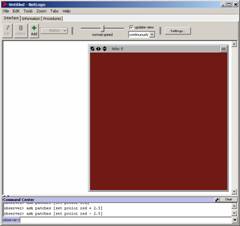
#NETLOGO SCALE COLOR HOW TO#
To get a deeper understanding of how to use the color schemes read the ColorBrewer paper (Harrower, Brewer 2003).Be sure to check the ColorBrewer web page.
#NETLOGO SCALE COLOR CODE#
There are a few examples of using the palette primitives in the Code Examples section of the models library:Īnd one Sample Model that uses the extension:
#NETLOGO SCALE COLOR PATCH#
You can observe that turning gradient on makes the model more aesthetic, but it becomes harder to estimate the value of a patch at a given position. In order to see the difference you can turn on and off the gradient in the Heat Diffusion model. Thus, discrete colors can be a better choice for a written document for which the user will have the time and interest to study the visualization. However, binning values in a discrete set of colors simplifies tasks such as estimation and counting by removing unnecessary detail and focusing on the big picture. Consequently, a gradient can be a better choice for presentations where the main goal of the image is to be attractive and memorable. The answer depends on the focus of the user experience.įor example, gradients are more aesthetic thus are more memorable than discrete colors. Should I use a continuous color gradient or just a discrete color set? See (Kornhauser, Wilensky, and Rand 1999) for design guidelines for visualization of Agent Based Models. You can learn more about the use of these color collections in the original ColorBrewer paper (Harrower, Brewer 2003), which focuses on their application to maps. For example, use different hues of pastel for patches and accent for turtles.

You can make a turtle more transparent by decreasing alpha, or increasing transparency.Ī similar approach can be used to adjust color components such as brightness.Īsk turtles ĬolorBrewer has three kinds of color schemes: Sequential, Divergent and Qualitative. The user can also create color gradients and access ColorBrewer color schemes. Change a specific component of an agent's color.Report a specific component of an agent's color.Report the result of changing a specific component of a color.

For more information, search the web for 'hsb color system.'.HSB Color SpecificationĬolors can also be specified (but not stored as color values) by reference to HSB - hue, saturation and brightness. Transparency is not stored as part of a color, but is mathematically converted to and from alpha. Transparency is in the range 0 to 100, with 0 fully opaque and 100 fully transparent. The degree to which one can see through a color can also be specified by referring to transparency. RGB/A will be used to denote a color that is either RGB or RGBA.Alpha represents transparency with 0 fully transparent, and 255 fully opaque.




 0 kommentar(er)
0 kommentar(er)
